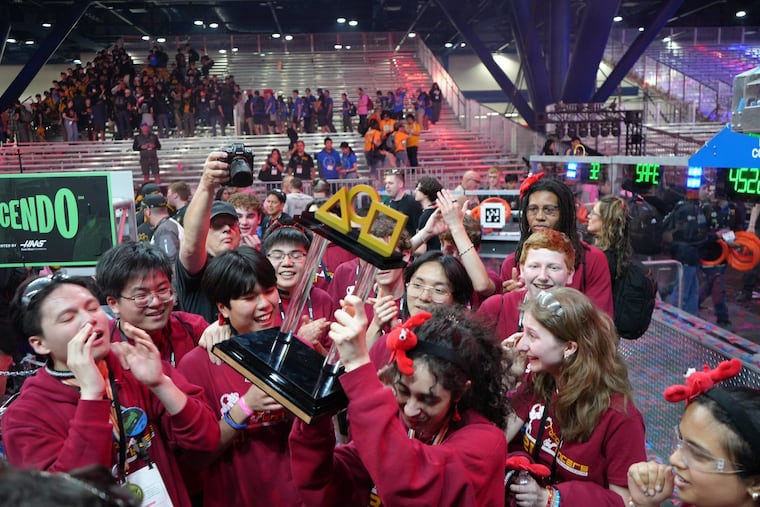Central High’s robotics team is now a world champion, having bested better-funded teams with ‘strategy and brains’
Other teams were wracked with nerves, but Central’s team walked around with lobster hats, a nod to Leonardo DaPinchi, their lobster-themed robot. (The RoboLancers call him Leo for short.)

More than 600 teams from around the globe traveled to Houston this month to compete for the world’s top robotics prize.
It came home with an underdog: Philly’s own Central High RoboLancers.
“Many of these teams have a lot more resources, have a lot more custom parts on their robots, and we had basically a regular drive train with worn-out wheels,” said Lily Sand, a Central junior, the team’s president, of what is called the FIRST Robotics Championship.
“It was through our strategy and brains that we were able to beat them,” Sand said. The competition has teams program and drive robots in game play on a specially designed field, with judges observing and awarding points.
The RoboLancers are a team on the rise, but sudden ascendance to the world championship shocked everyone, including them.
Two years ago, of the many awards offered, the team won nothing. Last year, the team wasn’t at all sure they’d even make it to the championship, held annually in Texas, but they won the FIRST Impact Award for their work around access and equity in science, technology, engineering, and math programs for Philadelphia public school students. That came with 10 years of automatic bids to worlds, and a permanent spot in the FIRST Hall of Fame.
To say they took advantage of that position is an understatement.
“We knew we could show up with a good robot, but we could show up with an even better plan,” said Cordell Beatty, a RoboLancers alum and the team’s drive coach since 2021. “Every time we touched down, we played good game strategy and our driver out-drove the field. We became the Broad Street Bullies on the field.”
Waltzing into the world championships as the Impact team, no one expected much out of the RoboLancers, who finished in the middle of the pack at the competition last year, said Yona Koresh, a junior and the robot driver.
Other teams were wracked with nerves, but Central’s team walked around with whimsical lobster hats, a nod to Leonardo DaPinchi, their lobster-themed robot. (Just call him Leo for short.)
That’s not to say the RoboLancers had no nerves. After the final match, the judges huddled for five full minutes before making their decision. There were tens of thousands of people packed into an arena, with tension music playing.
“I think it was the lack of expectance that sort of pushed us and allowed us to be in the position that we got it,” said Koresh. “There was a lack of stress — we just had fun throughout the competition. We thought, ‘No matter what happens, we knew our entire team would be so proud of what we achieved.”
Or, as junior Matt Perlman, a drive train member and the team’s programming lead, put it: “I really think being on the field, being in front of that stage was really magic. As a school, as a team, we never thought we’d be in that situation. We just went out there and had fun — until we won the world championship.”
The RoboLancers made it to the finals by virtue of getting chosen for an “alliance.” After qualifying rounds, top-ranked teams select other teams to make up their alliance. Each alliance has three robots and a backup robot.
Central was a backup robot, a sort of utility player. The world’s top teams comb through data and use sophisticated statistical models to make strategic choices about who would best complement their team.
“For us, it was just grit,” said Sand.
The RoboLancers were subbed in for the second match of the finals, and killed it. They played in every match thereafter.
“We became the secret weapon of our team,” said Perlman.
Isriah Keila, a RoboLancers coach, is thrilled for what the victory could mean for the RoboLancers, and for Philadelphia public schools generally.
“We’ve legitimized ourselves,” said Keila. “People thought Philadelphia doesn’t have the resources or attitude or people needed to do this work, and two years in a row, we proved everybody wrong. More and more people are coming out and saying, ‘This looks like something I can do.’”
That’s the goal. The RoboLancers work hard on competitions and their season, but that’s not their only mission. Through their nonprofit, the Philadelphia Robotics Coalition, the team supports more than 100 teams around the city, providing funding, training, workshops and events for students in grades K-12.
This year, the RoboLancers helped Bodine High School launch a robotics team, and they too made it to worlds in their rookie year.
But the Central students have their eyes fixed on more, not just for themselves, but for all robotics students in the area. Well-funded teams tend to have carpeted practice fields, which are slightly smaller than basketball courts, with low walls on two sides and higher walls on each end. But Philadelphia has none — the closest practice space is in Upper Bucks County.
“We need to have access to the same tools that everybody else has,” said Keila. “We want a field in Philadelphia.”